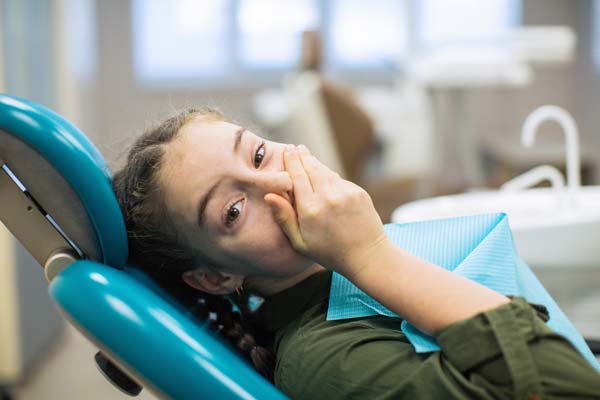How a Dentist Helps Relieve Pediatric Dental Anxiety

A child’s first trip to a dental clinic can be a momentous occasion, but pediatric dental anxiety can be a major source of stress for many children and parents. Understanding how a dentist could help address these fears during treatments can aid children in building healthy attitudes toward dental visits.
The fear of the unknown is a significant contributor to pediatric dental anxiety. Children do not know what to expect during their first appointment, which often leads to their imaginations running wild. Past negative experiences with a dentist, either firsthand experiences or stories passed over from peers, can also amplify these fears. Children also tend to be highly sensitive to their parents' emotions, so anxious caregivers can also contribute to dental anxiety.
Strategies a dentist might employ to alleviate pediatric dental anxiety
Children need to develop positive memories at the dentist early in life since doing so normalizes the idea of regular dental visits in their minds. Children who are not fearful or nervous when visiting the dentist are more likely to have good oral care routines as adults. Children who are terrified of dentists often grow into adults who never visit dental clinics until some dental emergency forces them to. Without further ado, here are some of the ways a dentist can help children with dental anxiety:
1. Provides a child-friendly environment
Many pediatric dentists take great care in designing their offices to be inviting and fun for children. This can include colorful decor, a play area, and child-oriented entertainment options. A child is less likely to feel anxious in a familiar and engaging environment.
A pediatric dentist’s clinic is specifically designed to cater to the needs of children, and the assistants are trained in ways to help children stay relaxed and comfortable during treatments. These clinics are often stocked with the latest toys and games to help children associate dental trips with positive memories. Even the tools a pediatric dentist uses to treat children are specifically designed for their smaller mouths.
2. Encourages open communication
A significant aspect of pediatric dental anxiety stems from the fear of the unknown. Dentists can counteract this by explaining each step of the process to the child in terms they can understand. Whether it is describing a dental tool as a "tooth tickler" or demonstrating how it works on their hand first, keeping the child informed can demystify the experience. Understanding what happens during a dental procedure helps keep patients of all ages relaxed in the dental chair.
3. Provides positive reinforcement
Rewarding children for bravery or cooperation can make a huge difference. This can be as simple as words of encouragement during the procedure or a small toy or sticker at the end of the visit. Such rewards make the current visit more pleasant and set a positive precedent for future visits.
4. Offers sedation dentistry for children
In cases of extreme pediatric dental anxiety or when lengthy procedures are necessary, sedation dentistry can be an option. This involves using safe and effective sedatives to relax the child during their dental treatment. It is crucial, however, that this is done under the supervision of trained professionals who can ensure the child's safety at all times.
The most common sedative used on children is nitrous oxide, commonly called laughing gas. It is a safe sedative that takes effect within minutes and makes patients feel happy and relaxed.
5. Involves parents during treatments
Sometimes, just the presence of a familiar face can help alleviate anxiety. Many kid’s dentists allow parents or guardians to stay in the room, hold the child's hand, or even have the child sit on their lap during the procedure. This comforting presence can make a world of difference.
6. Uses state-of-the-art equipment made for children
Modern dental technology has evolved to be less invasive and more comfortable. Tools are quieter and faster, treatments are less painful, and techniques have improved immensely. The utilization of this technology can make the dental experience less intimidating for children. Pediatric dentists often use smaller tools designed to be less intimidating and fit more easily in children's mouths.
7. Provides custom treatment for each child
Every child is unique. What works for one might not work for another. Experienced pediatric dentists understand this and will often have a range of strategies at their disposal. This flexibility ensures they can find the best approach for each child, addressing their fears and anxieties.
We can help your child get past their dental anxiety
Pediatric dental anxiety is a real concern, but it can be managed and often completely overcome with the right strategies and an understanding dentist. Call or stop by our Middletown clinic to set up an appointment with our pediatric dentist.
Request an appointment here: https://www.hvkidsmiles.com or call Hudson Valley Pediatric Dentistry at (845) 363-4177 for an appointment in our Middletown office.
Check out what others are saying about our services on Yelp: Read our Yelp reviews.
Recent Posts
In the past, traditional metal fillings were used to treat cavities. However, they tend to stand out against teeth and can look unnatural. Today, more parents prefer composite fillings for their children. These fillings serve the same purpose but with more natural-looking results. Dental fillings are relatively straightforward and do not require much aftercare. However,…
Composite fillings are commonly used to fix problems with a child’s teeth. A pediatric dentist may give the young patient and their parent a choice between composite fillings and other materials for their teeth. Each option has slightly different parameters for how long the filling will last and what you need to take care of…
Each year, increasing numbers of pediatric dentists offer advanced tooth-colored fillings instead of older metallic options. Still, many wonder whether these matching fillings look more natural than other filling types. The answer is yes, provided they are initially done correctly and properly taken care of afterward.Comparing enamel-colored fillings to other fillings and the original teeth…
Pediatric cavity treatment is a way to ensure that teeth do not fall out prematurely due to cavities and subsequently cause oral development concerns, speech development concerns, or excessive pain. In this review, we discuss everything that parents should know about pediatric cavity treatment so they can make informed and educated decisions about their child’s…


